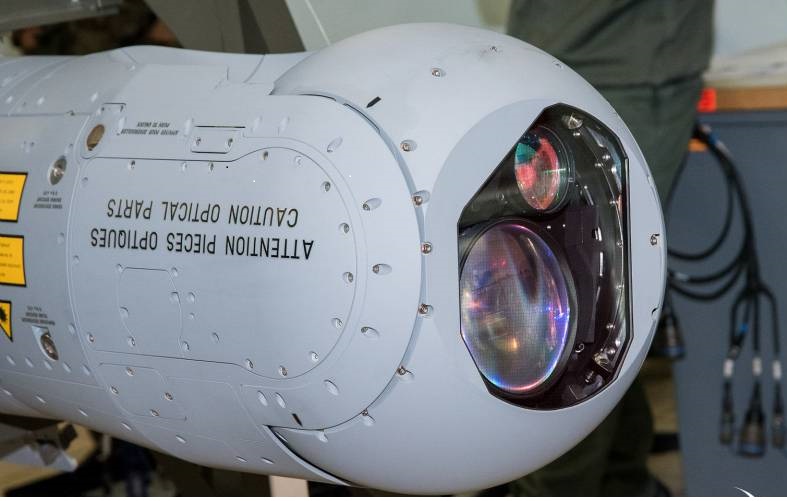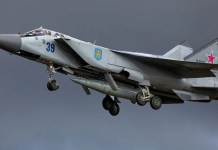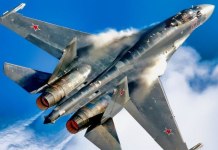The French Air and Space Force announced the initial operational capability (IOC) of the Talios laser designation pod on the Dassault Rafale F3-R multi-role fighter. The first flight of the F3R standard jet, which took place in September, saw an Indian air force (IAF) pilot operating from the rear-seat of the twin-seater jet.
The new Talios (Targeting Long-Range Identification Optronic System) targeting and laser designator pod, designed by Thales, brings full day and night surveillance and laser designation capability to the Rafale, with metric precision. It permits laser-guided weapons to be delivered at stand-off range and altitude.
The IR sensor of the Talios pod operates in the mid-wave infrared band and is coupled to a high-resolution new generation TV sensor.
The Indian Air Force (IAF), which has also acquired the multi-role Rafale fighters from France, was given the demonstration capabilities of the Talios pod in the air-to-air, air-to-ground, and air-to-sea domains, last month, according to the French Ministry of Defence.
The addition of Talios pod has enhanced the target acquisition system of the Rafales, which was earlier considered a disadvantage for the fighter.
The system is yet to be acquired by the Indian Air Force, which has been using variants of the Litening target acquisition system from Israel’s Rafael for several years now. Rafael had announced the supply of 164 Litening pods to the Indian Air Force in 2016.
Several fighter aircraft of the IAF currently employ the Litening, including the Mirage-2000, Jaguar, and Su-30MKI.
The IAF has opted for the HAMMER weapon system to be deployed on the Rafale, which originally comes with a Talios pod for firing. The Talios Pod could prove effective in delivering laser-guided bombs, especially in the Ladakh situation with China, when there is no better targeting system in existence.
Whether India agrees to acquire the Talios for its Rafale jets is unclear, and it will depend on the outcome of the Ladakh face-off. However, if deployed, the system will allow IAF to dominate all its adversaries in the optronics sector, giving the Indian pilots a unique edge while engaging this ‘eye in the sky.’
The October 29 tests, as announced by the French Ministry of Defense, conducted in an unnamed squadron manned by the Rafale, have indicated significant initial operational readiness of the system. The Talios is now believed to be capable of working in a full-fledged combat operation.

The system combines targeting and tactical recce capabilities in a single pod. It delivers unmatched image quality, including color imagery, and disruptive capabilities such as Permanent Visio and embedded artificial intelligence to provide combat aircraft pilots and ground forces with reliable situational awareness in real-time, according to Thales.
Flight-tested for the first time in 2016, Talios was successfully qualified by the French defense procurement agency in 2018 for deployment by Dassault’s Rafale Omni-role aircraft. The new-generation pod has been delivered to French forces and is now fully combat-ready.
Designed with support from the French defense procurement agency, Talios is the first and only system merging high-performance targeting and reconnaissance features in a single pod, covering the entire decision chain, from intelligence gathering through to threat neutralization.
Talios’ high-resolution sensor system can scan a wide area to search for targets in reconnaissance mode and, subsequently, moving target acquisition and tracking modes. The system generates a 3D mapping of the target area. The onboard artificial intelligence (AI) allows for automatic target recognition and target acquisition.
The pod supports deep strike with long-range bombs and missiles, air-to-air target identification, close air support (CAS), and Non-Traditional Information, Surveillance, and Reconnaissance.
What separates TALIOS from its predecessor DAMOCLES is the deployment of an advanced long-distance camera and the modernization of the IR band II (infrared) sensor. The human-system interface in Talios comes redesigned to giving the pilot all of the information required for understanding a complex tactical situation.
Damocles was also criticized for the lack of a “daytime” optical channel and other shortcomings, a feature which has been equipped in the Talios pod. The system is expected to gradually equip all Rafale squadrons of France’s Air and Space Force and will be deployed in foreign theaters of operation.





